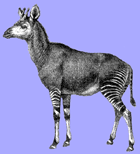
November 14, 2007

Cryptozoology has inspired some dynamic, colorful and intriguing logos for organizations, publications, and expeditions.
Concurrently today, I will share and launch the new Duncan Hopkins-designed logo for the International Cryptozoology Museum. But before that event, I wanted to give a tip of my fedora to the legacy of logos that exist in the field of cryptozoology and the species or cryptids tied to those symbols.
At the top of the page is the okapi used as the International Society of Cryptozoology’s official logo on their journal Cryptozoology, as well as the ISC Newsletter. The ISC was founded in 1982, and while there is no official “final” date for their termination, most opinion has tied it to the year 1993, despite attempts to get the organization to have a second life.
The ISC used a black and white rendering of the okapi, one of the primary animals of discovery within cryptozoology, as a useful and quickly recognizable symbol for the organization. The well-known, beautiful, but rare nature of the 1901-discovered okapi made for a striking logo to symbolize the ISC’s mission.
Indeed, as can be seen from this colored logo directly below, within cryptozoology, the okapi has remained a visible and useful image in the field. Here an Italian organization founded in the late 1980s decided to employ an okapi looking in a different direction for their logo.
The okapi and cryptozoology will always be symbolically united in the public’s eyes.
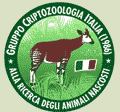
Other organizations have used similarly well-known species for quick recognition.

The United Kingdom-based Center for Fortean Zoology has had a thylacine as the centerpiece for their logo for many years. The CFZ thylacine is visible on their publications, website, and elsewhere, as the animal symbol that communicates their logo.
As opposed to an animal of discovery, the on-going story of the allegedly extinct thylacine, seen and searched for but not yet re-discovered, is the tale of an active cryptid of a known species.
As an observation, the parallel between the striping found on the okapi and the thylacine is subconsciously there in both logos. Simply put, it works well with humans. For those interesting in cryptozoology, the okapi and the thylacine seem as appealing as the giant panda does in the World Wildlife Fund logo.

The CFZ is to be congratulated for creating a logo that is now easily associated with their organization. The CFZ has used their logo to promote their web-based home videos of their excursions and their publications and press. The striking nature of their logo has given them identity and visibility.


However, the CFZ has a sense of humor too, and they tend to go away from their logo when they promote or publicize their treks, expeditions, and trips in pursuit of cryptids. Below are two examples for their excusions to Mongolia and Gambia.
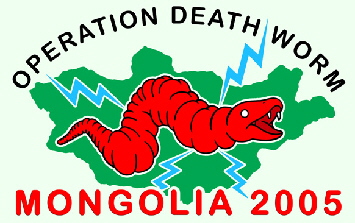

The following is the logo for their 2007 Guyana exploration.

Although not organizations, per se, in the era of the Internet, of course, websites are creating logos for themselves. Below is a cryptozoologically-theme one that displays the website url, the stylized use of “CZ,” and three cryptids, one being the thylacine again.
While the illustrations of the cryptids are interesting, for a logo, it tends to be busier than what is seen for logos, in general. Still, the artwork perhaps is good for the purposes of a website, and it may be useful for their group’s alignment. To me, the diversity of the Cryptozoology.com symbol is not as easy to grasp as that of the CFZ’s logo.
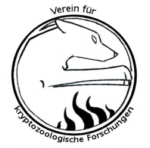

Another group that uses the thylacine is the Society for Cryptozoology-Research of Germany. See their logo and that of the network they are associated with are above.

The British Columbia Scientific Cryptozoology Club (BCSCC) was founded in 1989, and employ one logo that incorporates a drawing of a Cadborosaurus (the Cadboro Bay Sea Serpent) and a Sasquatch (Bigfoot). It honors the origins of the group and is still used today on some BCSCC tee-shirts.
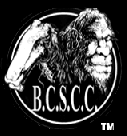
The BCSCC today also uses another logo.

In terms of a more contemporary flavor, the BCSCC is presently using a header on their homepage that contains their newest logo. The centerpiece is an image of Cadborosaurus (Caddy), unless it is Ogopogo, again.

Logos in cryptozoology are also used in relationship to conferences.
With regard to a European conference this month, see below, you can observe the use of various species of some importance to cryptozoology, including, once again the thylacine. But, also, please note in the logo in the upper left hand corner, the Sasquatch.

This blog would turn into a book if I examined all the uses of Bigfoot and Sasquatch in logos within the greater cryptozoology community of hominology and Bigfooter groups. The number has increased in recent years, and the symbolic nature of Bigfoot is always there for easy identification and labeling.
For example, using this flyer for the just completed Texas gathering, you can see the use of a logo – with a Bigfoot footprint in it – as well as the employment of a drawing of the creature itself.
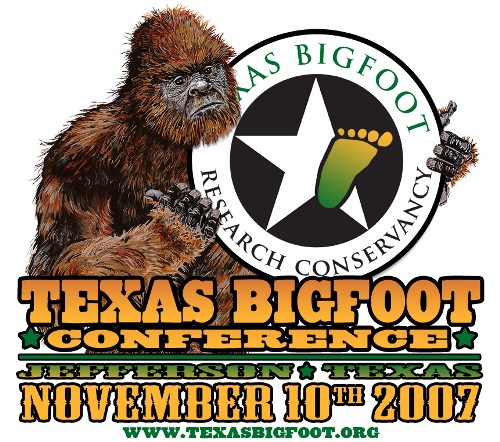
As an icon, Bigfoot turns up in many logos showing a group, club, or organization has a cryptozoological objective in mind. The explosion of the use of Bigfoot for cryptozoology groups is real.
But something else has happened in our culture. “Bigfoot” as an icon has been adopted by the greater society to symbolize power and more. Today, you can find Bigfoot used as a central theme in many logos, for example, as shown below by a communications company, a hockey team, and a student organization. “Bigfoot” does not just belong to cryptozoology any longer.



Next, to the story of the logo of the International Cryptozoology Museum (below), please click here.

About Loren Coleman
Loren Coleman is one of the world’s leading cryptozoologists, some say “the” leading living cryptozoologist. Certainly, he is acknowledged as the current living American researcher and writer who has most popularized cryptozoology in the late 20th and early 21st centuries.
Starting his fieldwork and investigations in 1960, after traveling and trekking extensively in pursuit of cryptozoological mysteries, Coleman began writing to share his experiences in 1969. An honorary member of Ivan T. Sanderson’s Society for the Investigation of the Unexplained in the 1970s, Coleman has been bestowed with similar honorary memberships of the North Idaho College Cryptozoology Club in 1983, and in subsequent years, that of the British Columbia Scientific Cryptozoology Club, CryptoSafari International, and other international organizations. He was also a Life Member and Benefactor of the International Society of Cryptozoology (now-defunct).
Loren Coleman’s daily blog, as a member of the Cryptomundo Team, served as an ongoing avenue of communication for the ever-growing body of cryptozoo news from 2005 through 2013. He returned as an infrequent contributor beginning Halloween week of 2015.
Coleman is the founder in 2003, and current director of the International Cryptozoology Museum in Portland, Maine.
Filed under Abominable Snowman, Alien Big Cats, Artifacts, Bigfoot, Breaking News, Comics, Conferences, Cryptid Canids, Cryptomundo Exclusive, Cryptotourism, CryptoZoo News, Cryptozoologists, Cryptozoology, Expedition Reports, Extinct, Eyewitness Accounts, Folklore, Lake Monsters, Living Dinosaurs, Loch Ness Monster, Media Appearances, Museums, Mystery Cats, New Species, Ogopogo, Photos, Pop Culture, Public Forum, Sasquatch, Sea Serpents, Thylacine, Yeti, Yowie